Development of external trade price indices - 2nd quarter of 2011
Publication Date: 15. 08. 2011
Product Code: a-7255-11
Quarter-on-quarter (q-o-q) comparison:
Export prices in Q2 2011, compared to Q1 2011, increased by 0.8% (in Q1 2011 they increased by 0.7%). Import prices increased by 0.5% (in Q1 2011 they rose by 2.3%).
In export prices increases were noticed in more important groups of 'manufactured goods classified chiefly by material' and 'chemicals and related products' identically by 2.7%, and of 'miscellaneous manufactured articles' by 0.8%. Prices drops were recorded in 'crude materials, inedible, except fuels' by 1.4% and in 'machinery and transport equipment’ by 0.8%.
In import prices rather important price increases were recorded in 'mineral fuels, lubricants and related materials' by 7.1%, 'chemicals and related products' by 1.4%, and in 'manufactured goods classified chiefly by material' by 0.4%. The prices that dropped were those of 'food and live animals' and of ‘machinery and transport equipment’ identically by 2.0%, and of 'miscellaneous manufactured articles' by 0.7%.
The terms of trade figures in Q2 2011, compared to Q1 2011, fell to 100.3% (in Q1 2011 they were 98.4%). Among more important groups, the positive values of terms of trade were reached in 'manufactured goods classified chiefly by material' (102.3%), 'miscellaneous manufactured articles' (101.5%), and 'machinery and transport equipment' (101.2%). More important negative values were recorded for 'crude materials, inedible, except fuels' (93.7%).
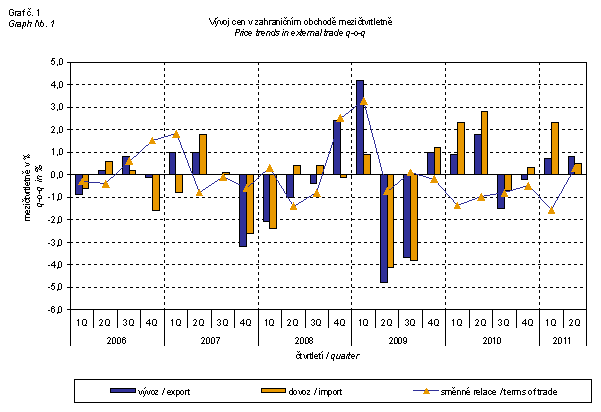
The external trade price development was also significantly affected by the CZK exchange rate to the major foreign currencies. The q-o-q exchange rate index includes two most important currencies from the Czech Republic’s external trade point of view, i.e. EUR and USD. Q-o-q indices of the CZK exchange rate to these currencies were weighted by the weight, which pertains to those foreign currencies in the export price index and import price index, respectively.

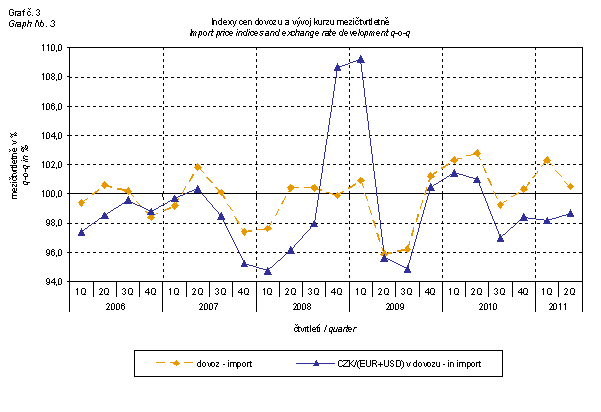
It can be seen from Graphs Nos. 2 and 3 above that in both cases of imports and exports external trade prices have a relation to exchange rate impacts. This relation could certainly be even stronger in the month-on-month (m-o-m) comparison; however, also in the q-o-q index it is relatively strong as the Graphs demonstrate. This conclusion is understandable because contracts with foreign entities are, as a rule, signed for a longer period of time and the longer the contract period is, the stronger the relation to exchange rates is.
Year-on-year (y-o-y) comparison:
Export prices in Q2 2011 decreased by 0.1% (in Q1 2011 they rose by 0.8%). Prices fell in 'machinery and transport equipment' by 5.0%, and those of 'miscellaneous manufactured articles' by 1.3%. More significant growth was reported for prices of 'mineral fuels, lubricants and related materials' by 14.1%, 'chemicals and related products' by 6.0%, and 'manufactured goods classified chiefly by material' by 4.7%.
Import prices in Q2 2011 increased by 2.4% (in Q1 2011 they rose by 4.7%). A growth of prices among the more important groups was indicated for 'crude materials, inedible, except fuels' by 31.9%, 'mineral fuels, lubricants and related materials' by 18.2%, 'manufactured goods classified chiefly by material' by 4.8%, and 'chemicals and related products' by 4.2%. Prices of 'machinery and transport equipment’ dropped most by 5.4% and those of 'miscellaneous manufactured articles' by 3.5%.
Terms of trade in Q2 2011 slightly increased in value, year-on-year, to 97.6% (by 1.3 percentage point (p.p.) more than in Q1 2011), nevertheless they continued in showing negative values for the sixth quarter – see Graph No. 4 below. Rather important negative values were recorded for 'crude materials, inedible, except fuels' (81.8%), 'mineral fuels, lubricants and related materials' (96.5%), and 'manufactured goods classified chiefly by material' (99.9%). Among more important groups, positive values of terms of trade were recorded in 'miscellaneous manufactured articles' (102.3%), 'chemicals and related products' (101.7%), and in 'machinery and transport equipment' (100.4%)

It follows from the aforementioned, that external trade prices are exposed to many effects, among others, also to the CZK exchange rate to foreign currencies. This influence is important and often even the decisive one. It is most pronounced in the m-o-m expression; but it is also very significant in the quarter-on-quarter comparison and substantially affects the level of y-o-y external trade price indices. The development of quarterly exchange rates (y-o-y changes) is demonstrated in Graph No. 5.
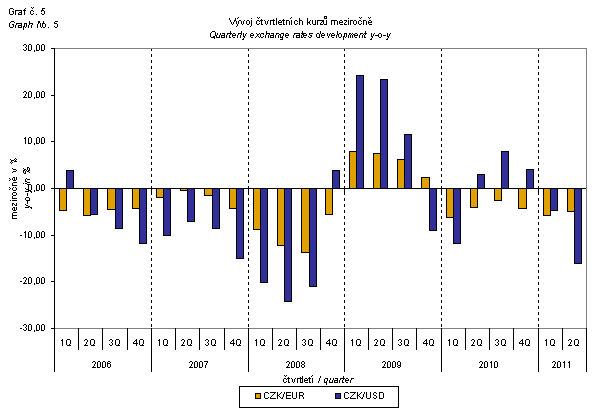
External trade price indices adjusted y-o-y for exchange rate influence
The CZSO carries out calculations of year-on-year external trade price indices adjusted for exchange rate influence. The method is prices in foreign currencies reported in the current month are converted into Czech crowns by the exchange rate of the same month of the last year. Then they are used for the weighted mean calculation along with prices reported in CZK. The year-on-year adjusted price index is then calculated the way that this exchange rate adjusted base price index is related to the non-adjusted base price index of the same month of the last year. Differences among adjusted and non-adjusted price indices may be substantial. They can be clearly seen in Graphs Nos. 6 and 7 for February 2009, for instance.
The method employed does not enable, for many practical reasons, to carry out the 100% exchange rate adjustment because all implementations in foreign currencies are not reported. This share is up to 30%. It follows from the aforementioned, that at the full exchange rate adjustment differences in between the price indices published and the exchange rate adjusted price indices would be even larger.
The aforementioned exchange rate adjusted indices can be used to form the exchange rate adjusted breakdown of price indices increments. Table 1, page 9, gives the published and exchange rate adjusted breakdown of increments of export and import price indices, expanded to the most important two-digit code groups of the SITC 7. This breakdown illustrates, in good manner, how many percentage points each of the groups “exchange rate contributed” to the index.
It holds in general that the exchange rate influence reduces the value of price indices in external trade if CZK is strengthening to foreign currencies in total. Conversely, the exchange rate influence pushes the price indices up if CZK is weakening to foreign currencies in total. It is clear from the following Graphs Nos. 6 and 7 how significant was the exchange rate impact on the value of export and import price indices.
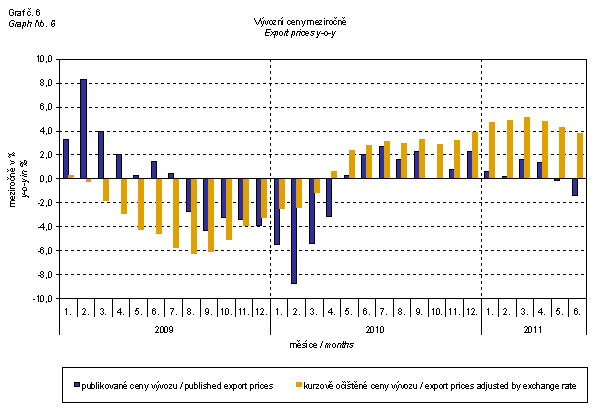
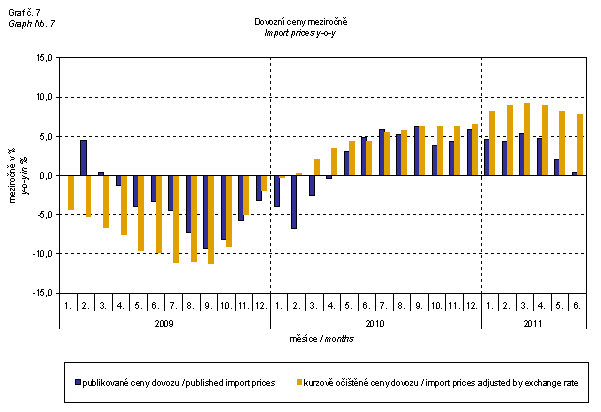
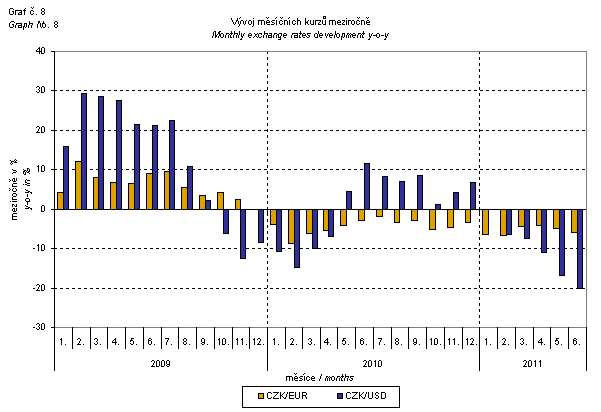
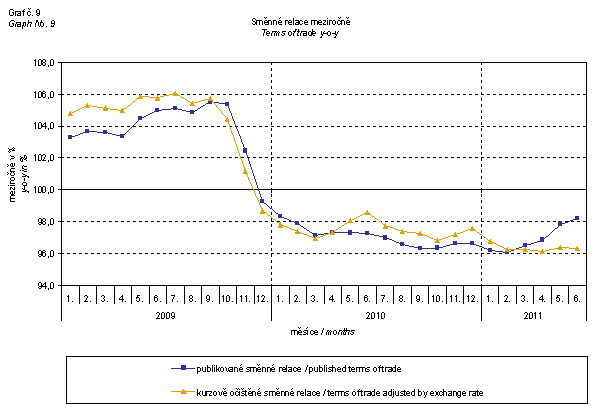
It can be seen from Graph No. 9 how the exchange rate influences the value of year-on-year terms of trade.
Graph No. 10 demonstrates the trend in the value of terms of trade, if the group of 'mineral fuels, lubricants and related materials' were excluded from the survey.
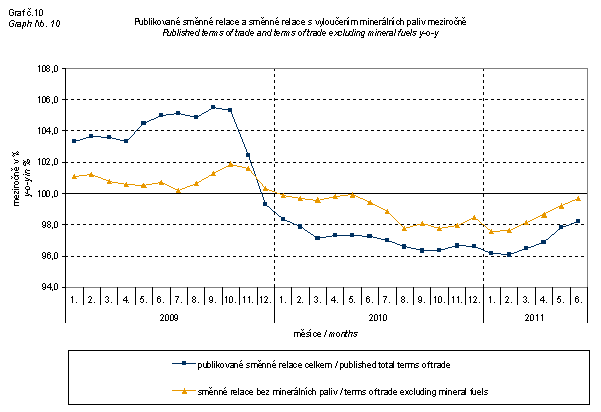
It can be observed in Graph No. 10 that 'mineral fuels, lubricants and related materials' increased the overall value of y-o-y terms of trade in the period from January 2009 to November 2009. This is most seen right in Q2 and Q3 2009. In Q4 2009 the situation began to reverse and in December 2009 'mineral fuels, lubricants and related materials' had again a downward effect on the value of terms of trade. It is, of course, related to the world market price development, especially in crude oil. Import prices, which, compared to export prices, include a higher proportion of crude materials, respond in a more sensitive way to price turbulences and therefore when prices of crude materials go up, terms of trade, as a rule, go down and, conversely, when prices of crude materials fall, terms of trade grow.
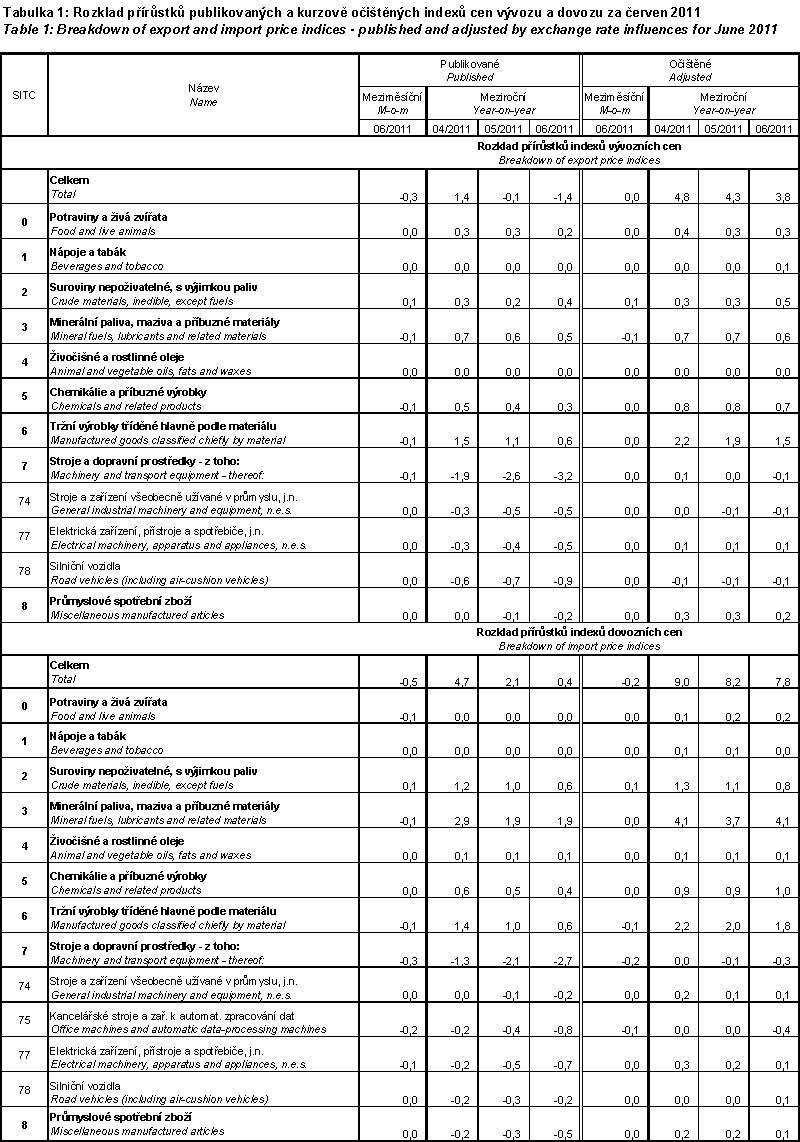
Closing Table gives published external trade price indices without adjustment.

Developed by: Vladimír Klimeš, Prices Statistics Department
Department Director: Jiří Mrázek, tel. (+420) 274 052 533
